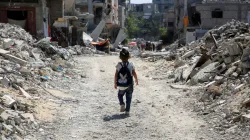Gaza's schools lie in ruins or have been turned into shelters for families displaced by a war that has killed tens of thousands. Yet teacher Israa Abu Mustafa refuses to let death and destruction deprive traumatised children of an education. After a four-storey building containing her home was demolished by an Israeli air strike, Abu Mustafa set up a classroom on the rubble under a tent.
Her impromptu school is one of the few remaining options for children in her neighbourhood.
Exposed to continuous bombing
"Children had aspirations before the war on the Gaza Strip, to become a doctor or an engineer. They had wishes and dreams. Children used to wake up, go to school normally. Children used to go to kindergarten and live their life normally without feeling afraid or insecure. Even though we have set up an educational tent here, we still need a sense of security because we are exposed to continuous bombing," said the brave teacher.
"During the war, we had to fill water gallons and collect sticks for firewood. Then Miss Israa found us and brought us here to continue learning," said 10-year-old Hala Abu Mustafa. The project began with 35 pupils and that number gradually increased to 70, ranging from preschool to sixth graders aged 11-12.
"Before the war, we used to study in schools, we used to play, and we were very happy. Then the war came, it destroyed our houses and bombed the schools. During the war, we had to fill water gallons and collect sticks for firewood. Then Miss (teacher) Israa found us and brought us here to continue learning. She set up a tent and let us learn and read in it," said the student.
How are schools running in war-torn Gaza?
Since the war began on Oct. 7, schools have been bombed or turned into shelters for displaced people, leaving Gaza's estimated 625,000 school-aged children unable to attend classes.
According to the Palestinian Ministry of Education, at least 10,490 school and university students have been killed in the Israeli offensive. More than 500 school teachers and university educators have also been killed.
The conflict erupted when the Palestinian militant group Hamas attacked southern Israel, killing 1,200 people and taking over 250 people hostage, according to Israeli tallies. Israel responded with a military campaign in Gaza, killing more than 40,861 Palestinians, according to Gaza health authorities. Israel says it goes to great lengths to avoid civilian casualties and accuses Hamas of using human shields and operating from schools, an allegation the group denies.
Classroom has become a distant dream
Abu Mustafa's lessons go beyond just a curriculum. Her classes provide a sense of structure and routine in the chaos. The tent is far from a traditional classroom where children once dreamed of one day studying abroad or becoming doctors and engineers who help the people of Gaza, which was impoverished and suffered from high unemployment long before the war erupted.
"We need chairs and tables so the children can learn properly instead of being forced to write on the ground," the 29-year-old teacher said. With limited resources, Abu Mustafa teaches basic lessons including religious studies, trying to keep her students engaged despite the relentless bombardment.
Gaza and the Israeli-occupied West Bank have internationally high literacy levels, and the under-resourced education system was a rare source of hope and pride among Palestinians. "What could be the child's wish? They have the right to learn in a safe environment, they have the right to play in safe place, to not feel any fear," Abu Mustafa said.
(With inputs from agency)
ALSO READ: 'I tried to save, but she was shot in her forehead': Gaza father breaks down as he buries daughter
Latest World News
